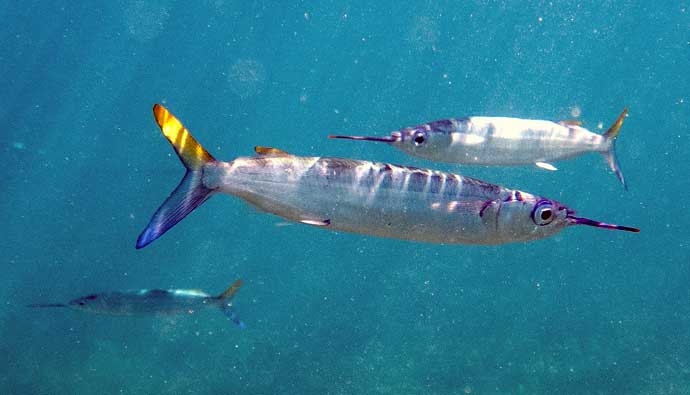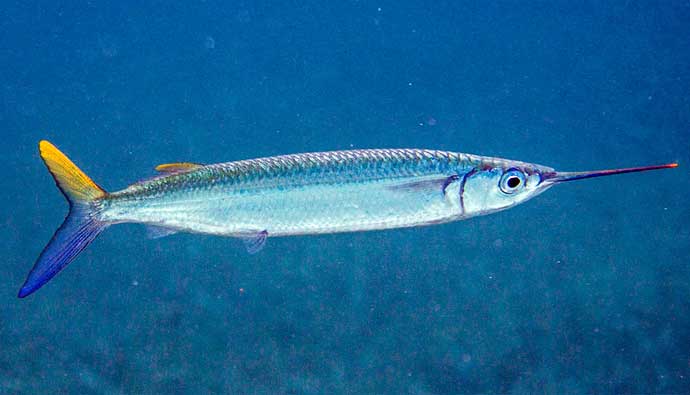What does ballyhoo fish mean and what does it have to do with the fish of the same name?
The word means ‘commotion,’ and since this fish has a habit of leaping and skittering over the surface, that is where its name comes from.

In this guide, we’ll show you how to catch this baitfish and how to rig one yourself to go after even bigger fish!
Overview
Also known as Redtailed Balao, Balahu, and Yellowtail Ballyhoo, this funny-looking fish is used as cut bait for trolling purposes.
It has a halfbeak for a snout and three stripes that extend the full length of its greenish back. The sides and the belly are silvery, and the caudal fin is a vibrant yellow to orange in color.
Ballyhoos can be found off the coast of Florida and in the Caribbean as well as off the coast of Massachusetts during the summer. Ballyhoo bait is considered to be the most common halfbeak bait used for pelagic species in North America.
Ballyhoo Facts
| Scientific Name: | Hemiramphus brasiliensis |
| Common Name(s): | Ballyhoo |
| Family: | Hemiramphidae (halfbeaks) |
| Identifying Characteristics | It has a halfbeak for a snout and three stripes that extend the full length of the greenish back. The sides and the belly are silvery, and the caudal fin is a vibrant yellow to orange in color. |
| Depth Range | 0 to 5 m |
| Habitat | Ballyhoo can be found off the coast of Florida and in the Caribbean as well as off the coast of Massachusetts during the summer. |
| Limits | Check your local regulations |
Ballyhoo Fish Habitat
Ballyhoo fish swims close to the surface of the water because it is chased there by predators. It can swim so fast that it actually skims the surface. The ballyhoo bait fish swims in large schools, so you can catch a dozen of them at a time using a simple net or by using Sabiki rigs.
When you are targeting ballyhoo, make sure your boat is anchored along a reef line, patch reef, or any other contour that can hold this fish.
Most reef lines that are located on the east coast all the way down to the keys hold large numbers.
How to Catch Ballyhoo
There are several ways to catch this ballyhoos, but since it remains close to the surface, the most popular method is using a chum bag.

Make sure there is a good, flowing current in the water so that the chum can make a nice slick. Wait for the ballyhoo to come close to the chum slick or till they are within netting distance. If you are using a rod and reel, drift the hook and bait on a bobber to attract the fish.
Once the school arrives close enough, squeeze a small piece of shrimp on a #10 hook and put a cork on the fishing line about 18 inches up from the bait.
Throw it about 2 feet across the school and then slowly reel back the hook bait through the fish. When the ballyhoo bites, maintain a steady retrieve and then lift it onto the deck. That is the best ballyhoo lure you can use that won’t damage the fish.
Ballyhoo Fishing Tactics
- Ballyhoo will spook as soon as you throw the net over them. Use a small 7 ft cast net to do this. You will be able to throw it about 20 feet from your boat and catch the fish even if it makes a run – or rather – a swim for it.
- Make sure that the current is lively enough to allow the net to spread out. If it is light or nonexistent, the net may sink too deep.
Ballyhoo Fishing Tips
- Get the ballyhoo into the bait well without touching it so that it lives long enough to be used as live bait.
- Use finely ground chum to attract ballyhoo rather than chunks. The large pieces can lodge in the net’s mesh, and the fish will feed on it from the outside.
Ballyhoo Fish Seasons
While ballyhoo fish can be done all year round, some commercial fisheries forbid fishing it during August when it spawns.
The bulk of the commercial harvest is predominantly from Miami to Key West. Especially after cold fronts that span the months between September and December.
In other words, the best time to catch ballyhoo in bulk is late fall and early winter. The good news is that the temperature has little to nothing to do with the quality of the fish.
How to Rig a Ballyhoo

Rigging ballyhoo bait is a skill you have to know if you want to use it as bait. Here’s how to make ballyhoo rigs:
- Tie a small piece of copper wire to a hook and make sure it is twisted tightly at the end. Leave a few inches of wire on the tag end.
- Hold the tag end of the wire and pierce the underside of the ballyhoo’s mouth. Make sure it only penetrates the lower jaw and not the smaller upper one. The fish will need to open its mouth as it swims.
- Pull the wire till the two halves of the wire are of equal length.
- Hold the leader wire firmly under the ballyhoo and wrap the copper wire twice around the head behind the pin.
- Loop the remaining wire around the head in front of the pin and halfway down to the bill.
- Break the beak in half close to the jaw with a quick snap, so you don’t damage the lower jaw. This will make the bait swim more naturally.
If rigging ballyhoo seems complicated, you can also buy pre-rigged ballyhoo to make it easier. Also, if you don’t have fresh ballyhoo around, you can use frozen ballyhoo for your baitfish rig.
Frequently Asked Questions
Most anglers use ballyhoo baits to catch sailfish, marlin, tuna, mahi-mahi, and wahoo. Yet, the baitfish are perfect for catching any species.
Green ballyhoo is the heartiest of the species, which maybe because of its grass diet. Red ones don’t last that long out of the water, which may be because of their plankton-based diet.
Algae, seagrass, plankton, smaller fish, decapods, and copepods.
Insider Advice
Ballyhoo may be easy to catch, but that doesn’t mean novices can net a large school on their first try. It takes time, a lot of patience, and the right conditions to catch a large school or enough to last a full day of fishing.
If you have tips and strategies to catch this fish in droves, share them in the comments below and share this guide if you liked it.




 Facebook
Facebook YouTube
YouTube









